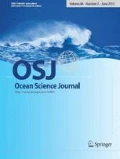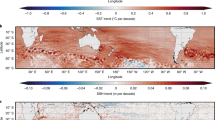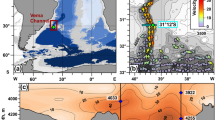Abstract
A simple analytical model is considered in an attempt to demonstrate a formation mechanism of the abyssal current in the East Sea. In this model, the abyssal currents are driven by wind through an outcrop region and flow along closed geostrophic contours. A rough estimate of the abyssal currents, arrived at by applying this model to the region of deep mixing in the East Sea, gives currents comparable to those observed, although there is an uncertainty in the surface area of the outcrop region. It seems that the spin-up of deep water by wind forcing through the region of deep winter mixing is, at least partly, an important contribution to the formation of the abyssal currents in the East Sea.
Similar content being viewed by others
References
Chang, K.I., N.G. Hogg, M.S. Suk, S.K. Byun, and K. Kim. 2002. Mean flow and variability in the southwestern East Sea.Deep-Sea Res. I,49, 2261–2279.
Gamo, T., Y. Nozaki, H. Sakai, T. Nakai, and H. Tsubota. 1986. Spacial and temporal variations of water characteristics in the Japan Sea bottom layer.J. Mar. Res.,44, 781–793.
Hendershott, M. 1989. The ventilated thermocline in quasigeostrophic approximation.J. Mar. Res.,47, 33–53.
Hogan, P. and H. Hulbert. 2000. Impact of upper ocean- topographical coupling and isopycnal outcropping in Japan/East Sea models with 1/8 to 1/64 resolution.J. Phys. Oceanogr.,30, 2535–2561.
Holloway, G., T. Sou, and M. Eby. 1995. Dynamics of circulation of the Japan Sea.J. Mar. Res.,53, 539–569.
Isobe, A. and Y. Isoda. 1997. Circulation in the Japan Basin, the northern part of the Japan Sea.J. Oceanogr.,53, 37–381.
Kang, D.-J., S. Park, Y.-G. Kim, K. Kim, and K.-R. Kim. 2003. A moving-boundary box model (MBBM) for oceans in change: An application to the East/Japan.Geophys. Res. Lett.,30(6), 1299, doi:10.1029/2002GL016486.
Kawabe, M. 1982. Branching of the Tsushima Current in the Japan Sea. II. Numercial experiment.J. Oceanogr.,38, 183–192.
Kawamura, H. and P. Wu. 1998. Formation mechanism of Japan Sea proper water in the flux center off Vladivostok,J. Geophys. Res.,103, 21611–21622.
Kawase, M. and D. Straub. 1991. Spin-up of source-driven circulation in an abyssal basin in presence of bottom topography.J. Phys. Oceanogr.,21, 1501–1514.
Kim, K. and J.-Y. Chung. 1984. On the salinity minimum layer and dissolved oxygen maximum layer in the East Sea(Japan Sea). p. 55–65. In:Ocean Hydrodynamics of the Japan and East China Seas, ed. by T. Ichiye. Elsevier, Amsterdam.
Kim, K., K.-R. Kim, D.-H. Min, Y. Volkov, J.-H. Yoon, and M. Takematsu. 2001. Warming and structural changes in the East (Japan) Sea: A clue to future changes in global oceans?Geophys. Res. Lett.,28(17), 3293–3296.
Kim, K. J. and Y. H. Seung. 1999. Formation and movement of the ESIW as modeled by MICOM.J. Oceanogr.,55, 369–382.
Luyten, J. R., J. Pedlosky, and H. Stommel. 1983. The ventilated thermocline.J. Phys. Oceanogr.,13, 292–309.
Na, J.-Y., J.-W. Seo, and S.-K. Han. 1992. Monthly-mean sea surface winds over the adjacent seas of the Korea peninsular.J. Kor. Soc. Oceanogr.,27, 1–10.
Rhines, P. B. and W. R. Young. 1982. A theory of the wind-driven circulation. I. Mid-Ocean gyres.J. Mar. Res.,40, 559–596.
Senjyu, T. and H. Sudo. 1994. The upper portion of the Japan Sea Proper Water: Its source and circulation as deduced from isopycnal analysis.J. Oceanogr.,50, 663–690.
Senjyu, T., T. Aramaki, S. Otosaka, O. Togawa, M. Danchenkov, E. Karasev, and Y. Volkov. 2002. Renewal of the bottom water after the winter 2000–2001 may spin-up the thermohaline circulation in the Japan Sea.Geophys. Res. Lett.,29(7), 1149, doi: 10.1029/2001GL014093.
Seung, Y. H. 1992. A simple model for separation of East Korean Warm Current and formation of North Korean Cold Current.J. Kor. Soc. Oceanogr.,27, 189–196.
Seung, Y. H. 1997. Application of ventilation theory to the East Sea.J. Kor. Soc. Oceanogr.,32, 8–16.
Seung, Y. H. and J. H. Yoon. 1995. Some features of winter convection in the Japan Sea.J. Oceanogr.,51, 61–73.
Takematsu, M., Z. Nagano, A. G. Ostrovskii, K. Kim, and Y. Volkov. 1999. Direct measurements of deep currents in the northern Japan Sea.J. Oceanogr.,55, 207–216.
Yoon, J. H. 1982a. Numerical experiment on the circulation in the Japan Sea. I. Formation of the East Korean warm current.J. Oceanogr.,38, 43–51.
Yoon, J. H. 1982b. Numerical experiment on the circulation in the Japan Sea. III. Mechanism of the nearshore branch of the Tsushima Current.J. Oceanogr.,38, 125–130.
Yoon, J. H. and H. Kawamura. 2002. The formation and circulation of the intermediate water in the Japan Sea.J. Oceanor.,58, 197–211.
Author information
Authors and Affiliations
Corresponding author
Rights and permissions
About this article
Cite this article
Seung, Y.H. Abyssal currents driven by a local wind forcing through deep mixed layer: implication to the east sea. Ocean Sci. J. 40, 101–107 (2005). https://doi.org/10.1007/BF03028590
Received:
Revised:
Accepted:
Issue Date:
DOI: https://doi.org/10.1007/BF03028590




